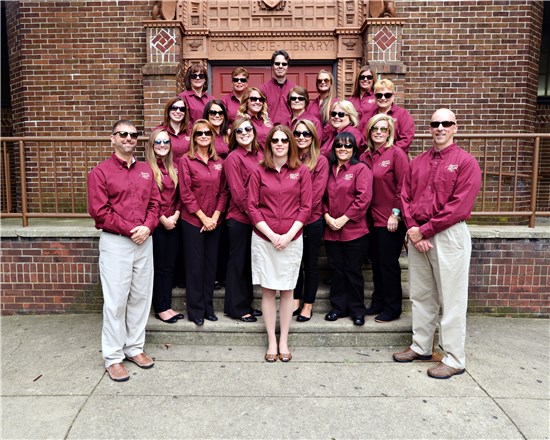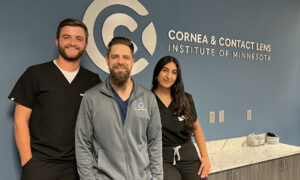By Dave Anderson, OD
June 1, 2016
Our office has gone through several major changes to office and staff operations in the last five years, and none has come without challenges. We’ve learned how to keep our staff informed of upcoming changes, and how to prepare them, so they are able to continue effectively serving our patients throughout transitions.
Change has been a constant for us. We began using EHR in 2011, and then incorporated a scribe system into our office. Shortly after, in 2013, we moved to a new building, expanding our space from 3,800 square feet to 7,400 square feet with 12 exam lanes and two pre-testing rooms. In 2014, we switched to a new EHR trying to gain better efficiencies. In 2015, we added a co-managing surgeon to our office, and just recently we hired a new associate.
The staff of Dr. Anderson’s practice, Miamisburg Vision Care, along with Dr. Anderson and the practice’s two other partners. Dr. Anderson says employees can best facilitate change when they are involved inpractice growth, and when theirideas are valued and implemented to meet practice goals.
Vet the Change
With any change that is implemented in the office we go through a vetting process to ensure the change is in line with our business philosophy and our practice’s mission–to be the best practice in our area providing the best care to patients. I look at all the potential challenges to reaching the next step, including how staff will be burdened, and I look at all the various costs and steps needed to make the change happen.
We then meet with our leadership staff, which includes our personnel manager, billing manager, optical manger and both partner doctors. We go over our plan, beginning with the issues our change is meant to either fix or improve, and we talk about all the steps to make the change and any potential “unintended consequences” that may occur. After this, we develop a plan and time frame needed to discuss with the remaining staff. We then develop a strategy and time frame with the input of the staff to ensure they buy in and help with the changes.
Get Staff Buy-In
Every time I involve staff, I begin the conversation with our mission and goal for patient care. I then begin with the issues that are happening where we hope the change will improve. For example, when we began discussing the office move, we discussed our parking issues, the space that we had for patient care, the optical and how full the office became during the day. I asked our staff to track all the times we had patients standing in our reception area because there was no room for them to sit.
Soon it was clear change was needed. In fact, after two days, our staff was surprised at the results, and recommended more chairs for the reception area than we originally planned because of what they observed. In general, I think it is best to always go over the positives, along with the current pain points, and then present the proposed change and its positive and potential pain points. After doing so, and laying out the main guideline for the change, let the staff become involved in the details for how the change is implemented.
CASE STUDY: A MAJOR CHANGE OUR PRACTICE MADE
Change: Conversion to EHR system
Goal: To switch to a new EHR system with no interruption to patient care or service
Process: Educate staff about the need to make the switch, such as what would be gained in patient care and office operations, and then to provide comprehensive training.
Staff Buy-In: Ask for staff input on the anticipated changes that will need to be made to office operations, along with their suggestions for making those changes go more smoothly.
Hurdles: Differing learning styles of individual staff members. The solution was providing one-on-one time with trainers, whenever necessary.
Result: A fully implemented new EHR system without interrupting patient care.
Train for the Change
Training is typically needed to implement any change. When we switched to a new EHR after having used a previous EHR for two years, we knew the training needed would be huge. I looked at the process that was available for training, and worked closely with the software trainers to find the right training solution for our staff.
We trained sometimes one-on-one with the trainers, and sometimes by watching a recorded webinar to learn the new software. We starting the training nearly two months before we implemented the new software.
We quickly learned that our staff all had different learning styles, some wanting to read more, some wanting more hands-on experience, and some wanting to watch videos on their own time. We then came up with a schedule during each week to allow for the training to occur without interrupting patient care.
Budget for the Change
I use a few strategies to ensure our budget is in line with any change. The first thing I do is have a conversation with my accountant. He knows our cash flow, understands our business and is very conservative. He gives me the worst case scenario, and makes sure we look at only the negative cash flow impacts. He always is good about underestimating the potential ROI, so we have a safer and more conservative approach to our changes.
The next thing we do is look at our current cash on hand, and make sure we have enough to cover day-to-day costs, such as payroll and other fixed expenses. Finally, we have had a great relationship with our local bank, and they have on hand a line of credit available to us of up to $50,000. This allows us to manage any cost overruns, or unforeseen issues that can occur with new changes. Once we know our finances are in order, we create the budget based on the changes we are making, and stick to this with close monitoring of the overall costs. For instance, when we built our new building, we overran our costs by only $10,000 on a building that cost over $1.2 million. We worked hard to keep within our budget, but lots of planning was involved to make this happen.
Update Staff During Process
The size of the project and the impact on staff determines the amount of updates that are needed. When the office was built, my partner and I met with the project manager 1-2 times per week, and the staff was involved at least 2-3 times a month. When we implemented EHRs, and during our switch to a different company, the staff was heavily involved, with nearly daily meetings. We would monitor the level of understanding each staff member had, and the understanding of the staff as a whole, and would work together to develop a familiarity with the EHR.
During our recent addition of the new associate, we have had weekly meetings discussing the new schedule, new hires for additional staff, and the credentialing process. Each change, whether large or small, has a different set of meetings and adjustments that will be needed. The most important thing is to have constant attention on the end goal, and to make sure all the details are falling into place. Being proactive, and not reactive, saves time, money and effort in every change that is implemented.
Manage Vendor Relationships During Change
Sometimes the change may affect either relationships, or work processes, with others that help support our business. Whether it is a frame vendor, or a sales rep for a pharmaceutical company, they are involved in most changes either by default or by our choice. Sometimes they just need to be in the loop regarding our time frame, which may alter our ability to meet with them, or perhaps related to new purchases being pushed farther down the road. I have always felt that we need to have a good message that is delivered from staff to patients, to vendors and anyone who works directly with our office to discuss the change. This includes the why, the timeline and the specifics that are changing. This allows them to adjust to our changes, but also allows for open communication with all parties, as we are never close-minded when others could provide some input or help in a project.
Inform Patients of Changes
I begin very early letting patients know about practice changes. I use a message that highlights the advantages while mentioning any aspect that could potentially interrupt patient care or convenience. When we moved to our new office, we began notifying patients over nine months prior to our move. We started with a press release and simple announcement about the purchase of new land with the proposed office rendering. We used this post on all of our social media sites and our web site and posted a large poster in the office to announce our move. We also sent out postcards to over 10,000 active patients with the announcement. I spent time mentioning the change to patients during office visits, and even pointed out some of the things we were doing to make their patient experience better in the near future, such as better parking and a larger optical area.
Get Outside Help, If Necessary
In our most recent change, the addition of an associate, we used an outside resource to help us with the contract and the negotiation, as well as looking at our cash flow and patient volume to asses the viability of the addition. We had already discussed with all other players, including our accountant, but the consultant helped us look at how the addition could be done and how to implement this change.
In a case where we are adding a large recurring payment to a doctor, I wanted to ensure both that they would be a good fit for our office, and that we would be able to pay them long-term.
Getting outside help comes down to a gut decision. The need to purchase a piece of equipment like an OCT or Optos that costs money is much easier to handle on your own than the payment on a new building or a new doctor. Much like buying a house versus a new pair of shoes, the bigger the financial investment, the more outside help may be needed.
Dave Anderson, OD, is a partner withMiamisburg Vision Care in Miamisburg, Ohio. To contact: doca@burgvision.com




























